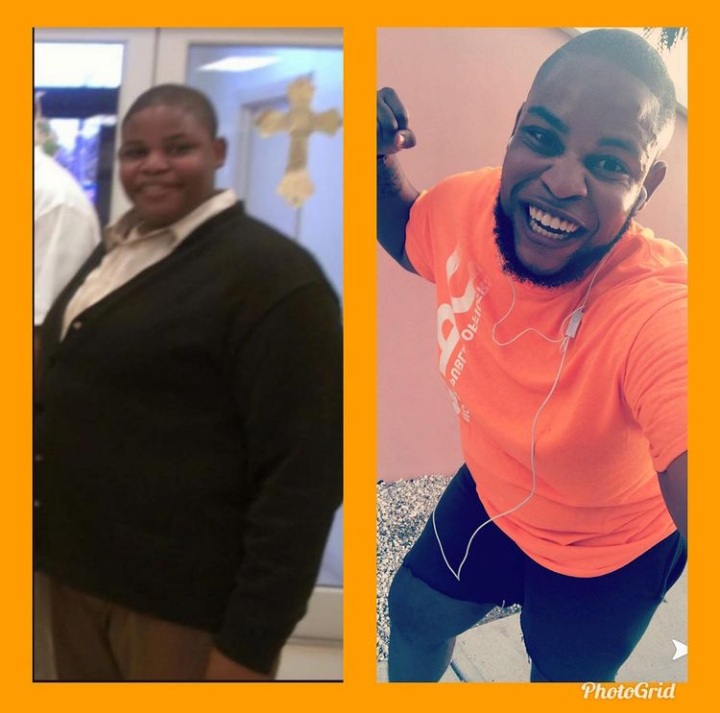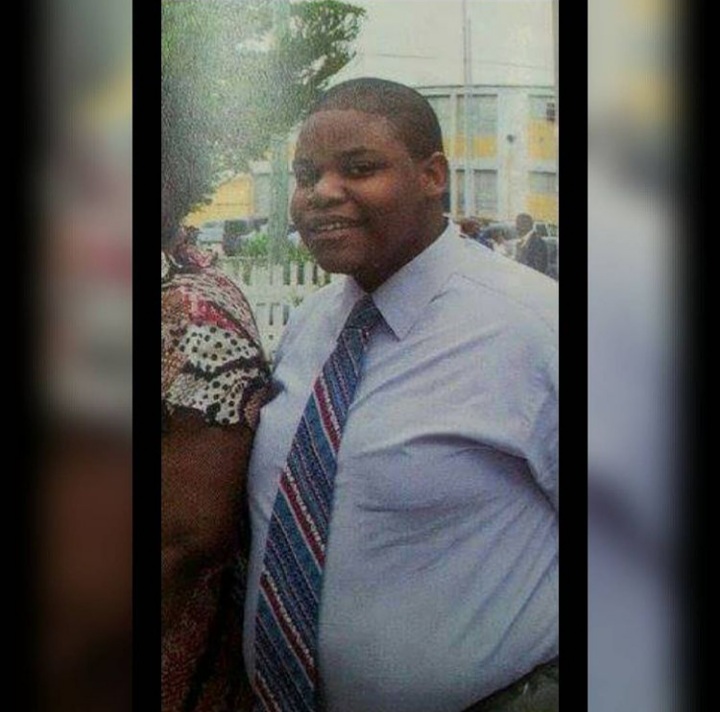'Consistency is Key': How One Young Man Changed His Life One Step At a Time

As the saying goes, a journey to a thousand miles begins with a single step, and from the moment Rayangelo Seymour took his first step towards better health, three years ago, he knew there was no better decision.
"I always looked at other persons and said this is what I aim for in my life. I looked at celebrities. I would go inside of a clothing store and think, 'I want to wear this,' but then it can't fit. Then, earlier in my life, when I had financial difficulties, I realized that whatever stuff I wanted, that was actually my size, was far too expensive and, mentally, it has an effect on an individual."
Diagnosed with hypertension, in 2019, at the age of 26, Seymour took that as a wake-up call.
"My hypertension is controlled based on weight loss, therefore, I decided that I would take my weight into my hands because I tend to look at the bad side of things," he explained.
"I wondered, if my hypertension is not controlled, what else is going to happen. It could affect my heart, it could affect my kidneys, it could affect my overall health. And there was a phase where I would've seen a lot of people having uncontrolled hypertension and what it was doing to them, causing them to go on dialysis, and that's something that I didn't want. So, I decided to venture out, not starting a diet, but a lifestyle change."
At the time of his diagnosis, Seymour weighed nearly 280 pounds. At his heaviest, in 2015, while in college, he hit a record 306 pounds. Currently, he's down to 157 pounds.
"Yes, I lost weight, but I also gained. I lost 50 pounds, gained 80. I lost 50 again, gained 100. It definitely was and continues to be a struggle, but I remember where I was, I appreciate where I am, and I keep in mind where it is that I want to go," he explained. "Rome was not built in a day. God created the world in six days and, on the seventh, He rested. So, it's about setting goals, attainable goals, and achieving them."
As he achieved each goal he set, Seymour quickly started to reap the benefits of all his hard work, citing self-control and discipline as the two biggest lessons he's learned throughout his journey.
"With self-control and discipline comes motivation because when I see that I've been consistent, I tend to lose more weight. My waist was a 48 (in inches) and is now down to a 26. Additionally, I sleep better and it affects my mood, my habits, and even my relationships. And it also affects my confidence. My confidence has peaked to a level where I don't worry about anybody else because I remember that I'm my own motivation," Seymour said, noting how people are quick to mention someone's weight gain and are just as quick to assume that the person must be "sick" when they've lost the weight.
Nonetheless, Seymour maintains that consistency is key.
"One thing I tell people is that I go to the gym by myself and I go running by myself. Yes, you can go to a gym class, but you do everything at your level," he said. "I try to monitor my progress and what I eat on a daily basis."
Seymour, who surpassed his goal weight of 160 pounds, and now aims to settle between 150 to 155 pounds, said he exercices six days a week.
"Every morning, from 4:50 to 6:30, I run six miles on Goodman's Bay Beach. I'm a part of my work's fitness program, so I teach a fitness class on Monday evening, between 5 and 6. On Tuesday, I go at the 66 steps (The Queen's Staircase). Wednesday, I go to Zumba. Thursday, I tackle the (Sir Sidney Poitier) bridge in the evening. Friday is happy hour time, so after I would've exercised that morning, I don't do anything that evening. Saturday, I exercise, but at 10:00 a.m. Sunday, I'm off."

Although Seymour, who revealed that his arms are now his favourite body part, is currently in the best shape of his life, he retains a period when this was furthest from reality.
"I would've encountered a few health challenges," he explained. "The first was in 2015, when I had my gallbladder removed. Of course, when your gallbladder is removed, you should watch what you eat, since bile (a fluid that is made and released by the liver) is stored in the gallbladder and helps to digest fats. I had some issues where I was experiencing these bad pains, thinking it was gas, but every time I took medication for gas, nothing worked."
As a result, Seymour decided to visit a doctor, who informed him that his condition was a life-or-death situation, as he had 30 gallstones - 21 of which were lodged throughout his intestines.
"We had to have them removed, as they affected my bilirubin (yellowish pigment found in bile) flow, and my liver, which led to me developing jaundice," he explained.
Without a gallbladder, the body won't be able to break down fats as quickly, leading to some foods that won't be totally digested before needing to make a bowel movement, which can lead to an enlarged stomach, especially with a poor diet - only further prompting Seymour to adopt a lifestyle change.
He added, "I remember when I walked and got out of breath. I remember waking up every morning where on the side of my bed was one small pill with a glass of warm water. There was one morning when I was driving to work and I had to turn right back around because I forgot I had to take a pressure pill and my body was so dependent on it. But I am now free of that and feeling better."
Seymour, now 28, has been off of pressure pills since April 2021.
"Healing is in the land," he said. "Sickness is attributed to what we ingest, what we eat. Therefore, the same way what we eat can make us sick is the same way what we eat can heal us."
Acknowledging June as Men's Heart Health Month, Seymour said his focus is on his diet.
"As a man, I have an opportunity to lose weight quicker than a female because, of course, females' bodies are different, the genetic makeup is different. So, I try not to take that for granted," he explained. "What I consume can improve the different functions of my body. With that in mind, when you think about hypertension, you think about cardio, you think about heart health. So, I decided to watch what I eat, exercise and now my pressure has stabilized. That was the standard I set for myself, taking my health into perspective."
Although he prescribes to his trainer's 80/20 rule, where 80% of weight loss is diet, and the remaining 20% is exercise, Seymour also enjoys a cheat day every once in a while.
"I was just telling my fitness class that the body is tricky, which means that you have to know your body. If I go out on a Saturday, because Saturdays are usually my cheat day, and come back home Sunday morning, around 3:00 or 4:00, I would have something deep-fried, or cook something I really like," noting that there is a theory behind this phenomenon which he has proven to be true.
"Your first meal of the day should be your heaviest meal. So, I found that my dinner is what I have for breakfast because I have the rest of the day to burn it all off," he explained, noting that the secret is to eat smaller portions but as frequently as possible.
"A lot of people don't know what smaller portions look like. Experts say do not let your starch be larger than your fist; let your meat be able to fit in the palm of your hand; and you can go crazy with your greens."
While the 80/20 rule does yield results when it comes to diet and exercise, weight loss is also just as much about the mind as it is about the body.
"I have a few friends where we motivate each other. They always ask me what it is that I've been doing that we can do together, so we exercise together and share what we eat," said Seymour. "Also, my mother is 60, so whenever I cook, we try to motivate each other. She has no choice but to eat healthy with me because I'm the one who cooks now."
Seymour expressed that his favourite fruit is an apple and that he also loves plums, bananas, cantaloupes and papaya. He also noted that he has a newfound love for carrots, broccoli and the potato.
And while he never thought he would have ever seen a number higher than 300 on the scale, he also never thought he'd see the day that he would be as fit as he is now.
"To be honest, I don't know what was happening to my body chemistry, but everything I did, I gained weight. So, it was like, I drank water, I gained weight. I got up and I looked outside, I gained weight. Everything I did, I gained weight. I don't know what happened but I knew it was me not being accountable to a healthy lifestyle," he explained.
"I always set goals because it was about setting goals and achieving them. But after I would've achieved a particular goal, I, again, tried to set other goals. So, if I'm at 277 pounds, I'd want to get to 270 pounds, then move from 270 pounds to 260. Sometimes, it becomes discouraging because you're going to plateau. But once I've plateaued, because I've been so consistent with eating healthy, I then try to shock my metabolism by having something that is high in carbs, shortly after I would've exercised, so that my metabolism speeds up and I'm burning fat and losing weight again."

Seymour, who admits that the journey is ongoing, said he is proud of how far he has come and offers this advice to others - know your body and be consistent.
"You need to set goals. Make sure that whatever goals you set are aligned with your body. Make sure you monitor your pace and don't monitor anyone else's pace. There will be a period of transition where you want to look like someone else but, again, at the end of the day, don't try to look like anybody, focus on looking like a better and healthier you," he said.
"Everybody's fitness capabilities is different. What my fitness capability is now is not what it is a year and a half ago. For example, I've mastered running six miles. I can do that within an hour and a half, but now that I know that I can do that within an hour and a half, I now want to master running those six miles in an hour and 15 minutes. So, it's about improvement. Even if you're going to the gym and lifting 10 pounds with 20 reps, increase. Do more reps lifting 15 pounds compared to the amount of reps you would've done with 10 pounds. It's all about challenging yourself."
